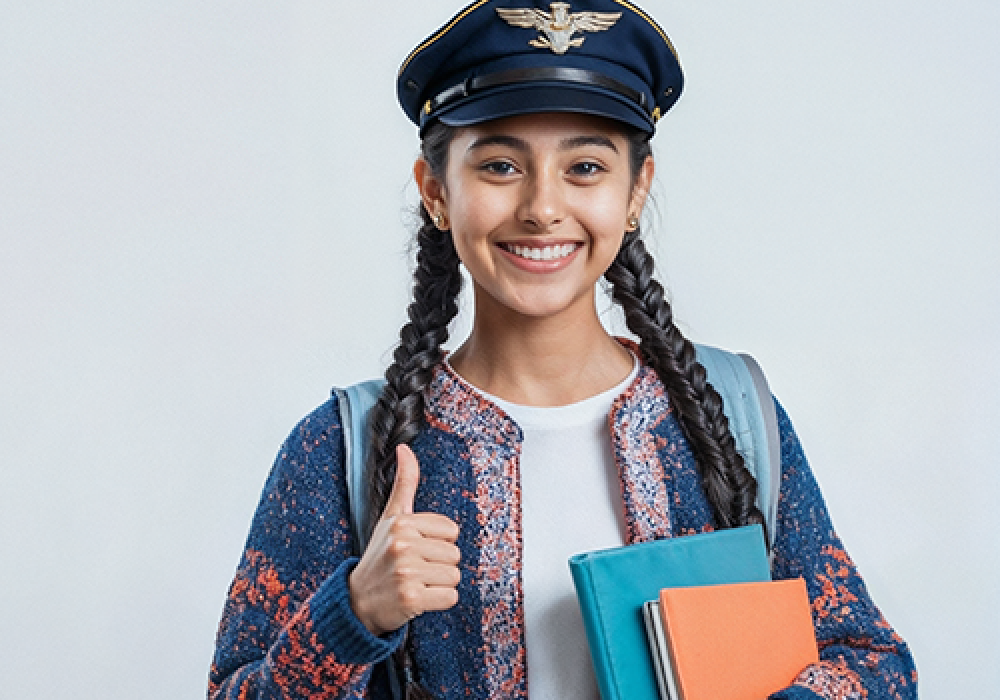Pursuing a career as a pilot in India after completing Class 12th is more than just an aspiration; it's a practical step into one of the fastest-growing industries in the country.
Over the coming years, the aviation sector will need over 21,000 new pilots. IndiGo is projected to hire 11,778, Air India around 5,870, Air India Express 2,196 by FY 2028, and SpiceJet 1,630. With such demand on the horizon, this is the right time to prepare for a rewarding and future-proof career.
Eligibility Criteria for Becoming a Pilot
The foundation of your pilot career begins with meeting specific eligibility requirements established by the Directorate General of Civil Aviation (DGCA).
Educational Qualifications:
- You must have completed Class 12th (10+2) from a recognized board with Physics and Mathematics as mandatory subjects.
- A minimum of 50-60% marks is typically required, though this may vary by flying school.
- Suppose you haven't studied Physics and Mathematics in your 12th grade. In that case, you can complete these subjects through the National Institute of Open Schooling (NIOS) or equivalent institutions.
Age Requirements
The minimum age requirements vary depending on the type of pilot license
- Student Pilot License (SPL): Minimum 16 years
- Private Pilot License (PPL): Minimum 17 years
- Commercial Pilot License (CPL): Minimum 18 years
Medical Fitness
Medical certification is crucial for pilot eligibility. To begin training, you must obtain a Class 2 Medical Certificate from a DGCA-approved medical examiner.
For commercial operations, a Class 1 Medical Certificate is mandatory. The medical examination covers vision, hearing, cardiovascular health, and overall physical and mental fitness.
Learn more about DGCA Class 1 and Class 2 Medical Certificates
Other Requirements
- You must be an Indian citizen
- Strong English language proficiency is essential
- Good physical fitness and mental health
Two Primary Pathways to Become a Pilot
1. Commercial Aviation Route (CPL Training)
2. Indian Air Force Route (Through NDA/CDS)
1. Commercial Aviation Route (CPL Training)
This is the most common pathway for aspiring commercial pilots in India.
Step-by-Step Process:
Phase 1: Groundwork (4 months)
- Apply for DGCA Computer Number through pariksha.dgca.gov.in
- Prepare for and pass DGCA theory examinations (4-5 subjects)
- Obtain Class 2 Medical Certificate
- Complete eGCA registration
Phase 2: Flight Training (12-18 months)
- Enroll in a DGCA-approved flying school
- Complete 200 flying hours as per DGCA requirements
- 100 hours as Pilot-in-Command (PIC)
- 50 hours solo cross-country
- 40 hours instrument flight (20 may be on simulator)
- 15 hours multi-engine training
- 10 hours night flying
Phase 3: License Issuance (2-3 months)
- Complete DGCA skill tests with appointed examiners
- Submit required documentation to DGCA
- Receive Commercial Pilot License
Phase 4: Employment (Variable timeline)
- Build flying hours and gain experience
- Apply for airline positions or charter operations
2. Indian Air Force Route (Through NDA/CDS)
The military route offers a prestigious pathway to become a fighter or transport pilot.
National Defence Academy (NDA) Entry:
- Age requirement: 16.5-19.5 years
- Pass UPSC NDA examination (conducted twice yearly)
- Clear Services Selection Board (SSB) interview
- Pass medical examination and Pilot Aptitude Battery Test (PABT)
- Complete 3 years training at NDA
- Undergo specialized flying training at Air Force Academy
Training Costs and Financial Investment
Pilot training requires substantial financial investment.
Training Costs in India:
- Complete CPL Training: ₹35-55 lakhs (As of 2025)
- Private Pilot License (PPL): ₹10-12 lakhs (As of 2025)
- Commercial Pilot License: ₹45-55 lakhs (As of 2025)
Financing Options:
- Education loans from banks for DGCA-approved schools.
- Installment payment plans offered by flying schools.
- Scholarships for academically excellent students.
- Cadet programs by airlines.
Training Timeline and Duration
The complete journey from Class 12th to becoming a commercial pilot typically takes 2-3 years:
Detailed Timeline
- Student Pilot License: 1-2 months
- Private Pilot License: 6-12 months
- Commercial Pilot License: 12-18 months
Total Duration: 18-36 months, depending on training intensity and school efficiency.
Factors Affecting Duration:
- Flight school quality and aircraft availability
- Weather conditions
- DGCA exam scheduling
- Financial readiness for continuous training
Steps to Get Started
Immediate Action Plan:
- Assess Your Eligibility: Verify your Class 12th marks and subjects
- Get Medical Clearance: Visit a DGCA-approved medical center for Class 2 Medical
- Apply for DGCA Computer Number: Complete online application at pariksha.dgca.gov.in
- Research Flying Schools: Compare DGCA-approved institutions based on cost, location, and facilities
- Arrange Financing: Explore education loans and payment options
- Begin Ground Studies: Start preparing for DGCA theory examinations
Essential Documentation
- Class 10th and 12th mark sheets
- Passport-size photographs
- Identity proof (Aadhar card/Passport)
- Medical certificates
- Educational board verification certificates
Becoming a pilot after Class 12 can be among the most exciting and rewarding decisions. With the proper planning, dedication, and financial commitment, it's possible to chart your course from the classroom to the skies and build a respected career as a professional aviator.
It's important to remember that this path demands more than just passion; it requires discipline, a strong focus on safety, and a willingness to keep learning throughout your career. The training can be intense, and the investment is significant. However, for those who love flying, the sense of achievement, financial stability, and sheer joy of being in the air make it all worthwhile.
Disclaimer:
This article is intended for informational purposes only and does not constitute legal or regulatory advice. While every effort has been made to ensure accuracy, applicants are advised to refer to the official DGCA Pariksha portal and consult authorized professionals or aviation training institutions for guidance tailored to their specific cases. Wing Path and the authors are not responsible for any outcomes resulting from misinterpretation or misapplication of the information provided.

